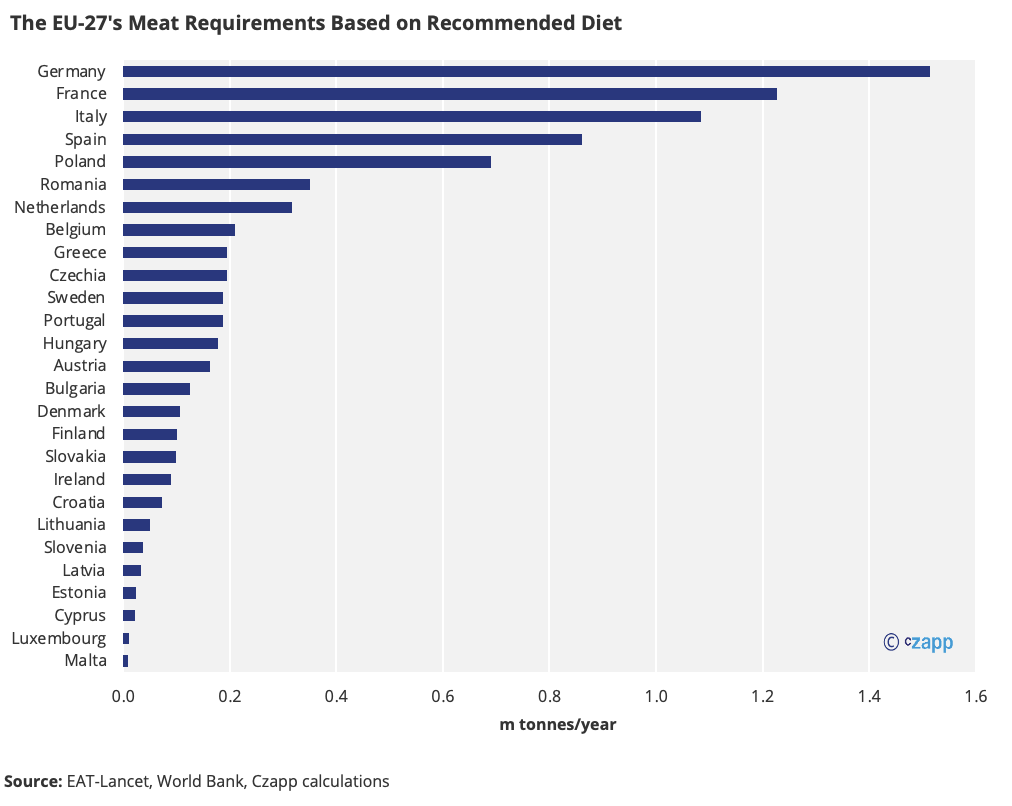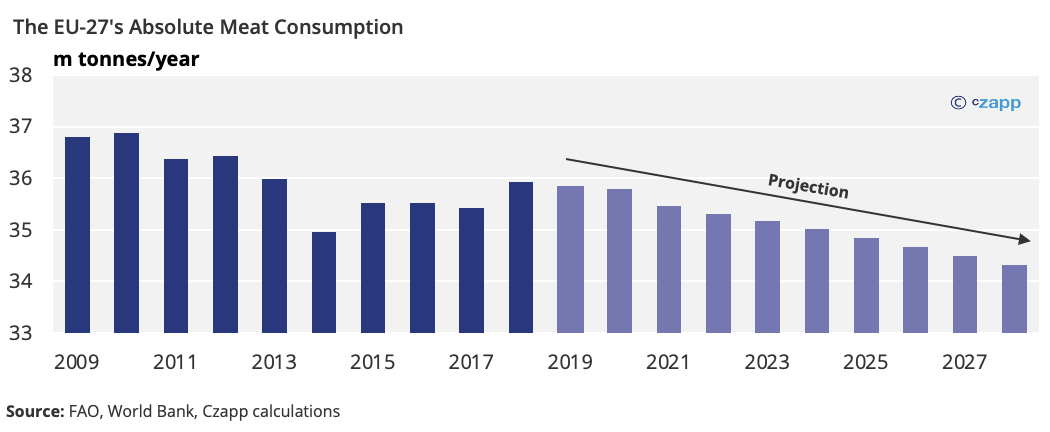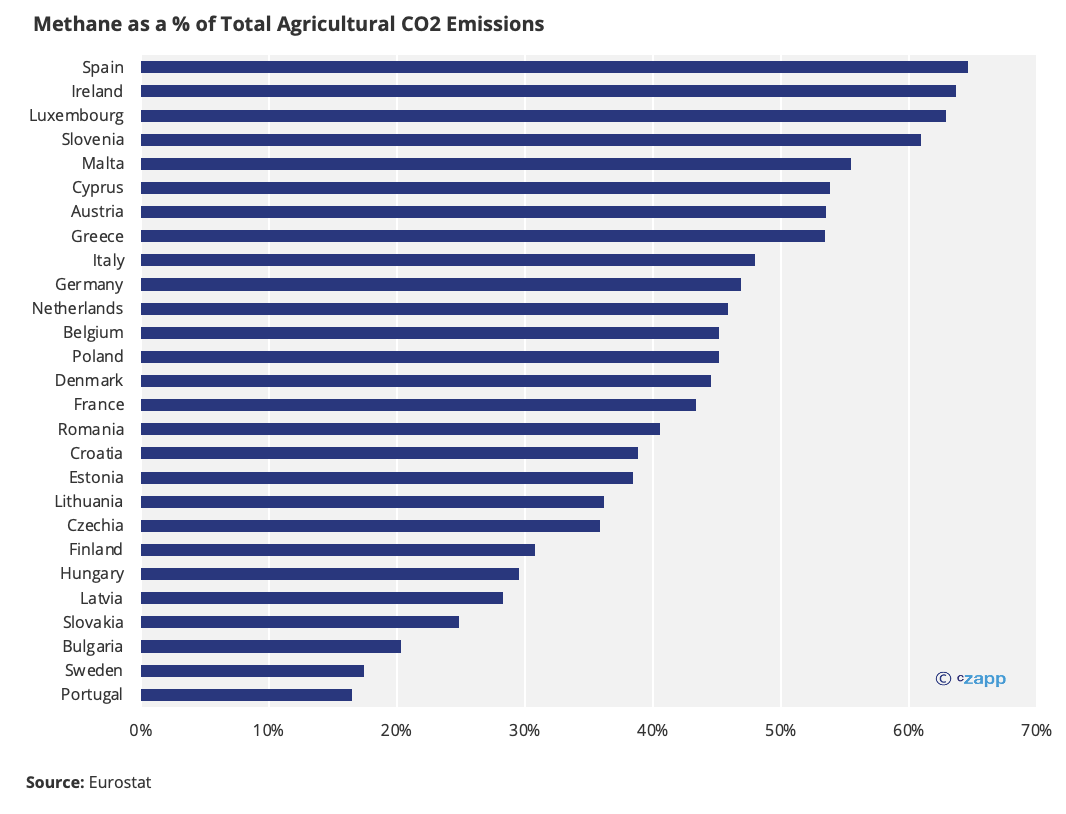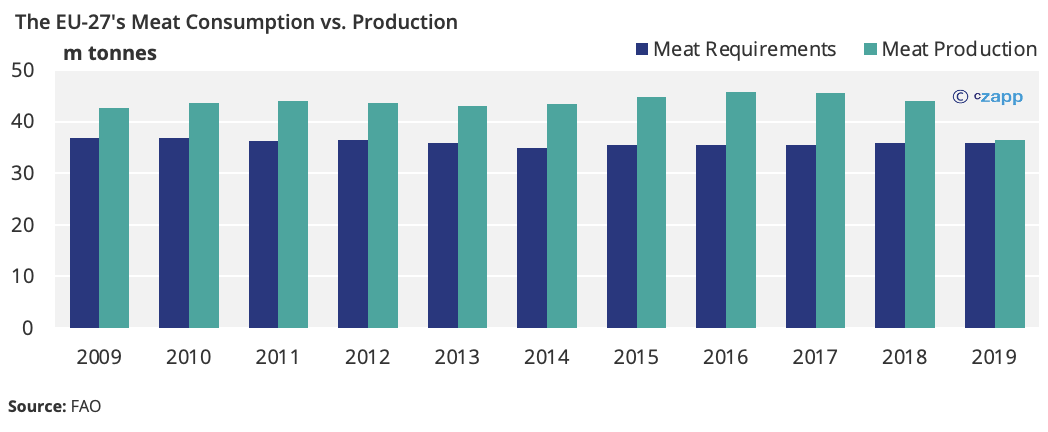- The Farm to Fork strategy’s goals for animals and livestock are less concrete than other areas.
- The EU aims to promote more sustainable livestock farming, avoid carbon leakage from livestock imports and revise animal welfare regulation.
- Some of these goals may be easier to achieve than others.
The European Union’s Farm to Fork strategy was launched in May 2020 under the framework of the European Green Deal.
The strategy sets out several pledges and targets for the EU to reach by 2030 with the goal of creating a more sustainable, environmentally friendly food value chain.
While some proposals are more specific than others, the Farm to Fork strategy is an ambitious plan but it has invited some criticism. Over this eight-part series, we aim to provide you with a greater understanding of the policy’s implications and how it might affect your day-to-day business.
EU Meat Requirements
According to EAT-Lancet’s dietary recommendations, the average human needs around 350g per week, or 18.2kg of meat per year. Based on the 2020 population, this would mean the EU-27 requires about 8.2m tonnes per year.

But the data shows that EU citizens are consuming much more meat than the recommended amount, with 2018’s total meat consumption coming in at 35.9m tonnes per year – more than four times what’s needed.
Even though some are already looking at plant-based alternatives and shifting to vegetarian and vegan diets, it’s unlikely tastes will change radically in the coming years, so meat consumption shouldn’t drop substantially.
In the European Commission’s medium term agricultural outlook, it estimates that consumption will dip by 1.6% per capita by 2030.

Based on historical consumption, EU growth projections and UN population estimates, we’ve modelled a business-as-usual case for meat consumption to 2028.

It’s worth noting that the sharp drop in consumption seen in 2014 is most likely due to record high meat prices, rather than a consumer aversion to meat. So, although per capita consumption should drop, this is unlikely to happen at a rapid pace.
A Step Toward Sustainable
With the EU still expected to require almost 34.5m tonnes of meat by 2028, what’s the most sustainable way to guarantee supply? Is it to guarantee own production and cut down on imports? Or should the EU reduce its own livestock capacity and increase imports?
The first scenario may not be ideal given that methane – largely produced by livestock – currently accounts for around 55% of all agricultural CO2 emissions. In some countries, including Ireland, Luxembourg, Spain and Slovenia, the proportion exceeds 60%.

And despite a projected dip in demand, land requirements would still be extensive. Based on current livestock density, yield, and meat requirement data, by 2028, the EU would still need 112.3m hectares of agricultural land to maintain enough meat output.
The EU could become self-sufficient in meat production and eliminate imports entirely, given that its meat production generally outstrips meat consumption by an average of about 7.4m tonnes per year.

Imports currently account for a very small proportion of the EU’s meat supply, at just 3.5% on average over the last 10 years.

If it were to cut down on imports completely, no significant land expansion would be required, and therefore emissions should remain stable. But given that methane from agriculture alone accounts for over 200 million tonnes of CO2 equivalent per year, cutting into this would go a long way to allowing the EU to reach its net zero goals.
There’s also the consideration of intra-EU trade, given that the meat is not always needed where it’s cultivated or slaughtered. This creates the need for trade of around 11m tonnes of meat between EU nations, adding to carbon footprints.
Becoming a Meat Importer
Becoming a net importer is never the ideal scenario as blocs can become vulnerable to market volatility or shortages, as witnessed during the COVID-related supply chain disruptions. And although the EU would cut out at least 200m tonnes of CO2 equivalent per year, would this be replaced by carbon imports?
Well, the answer is that it depends on a few things. Agricultural transport accounts for remarkably little in the grand scheme of things. While every 1kg of beef runs up 16.3kg of CO2 and the actual farming process accounts for 39.4kg of CO2, transport generates just 300g of CO2. This means that, if the EU were to import its entire 35m tonnes of meat required, it would generate about 10.5m tonnes of CO2 – significantly less than the amount generated by domestic agriculture.

However, it’s not quite that simple either. The agricultural processes in different countries generate varying levels of CO2 emissions. While the EU average for per capita agricultural emissions is around 6 tonnes, this skyrockets to 37 tonnes in Qatar, 23 tonnes in South Korea and 14 tonnes in the US and Canada.
Currently, the EU’s largest trade partners in meat products outside of the EU are Argentina, Brazil, New Zealand, and the UK, which register CO2 emissions of 3.45 tonnes, 2.19 tonnes, 6.6 tonnes and 5 tonnes, respectively each year. To source 35m tonnes of meat, the EU would have to expand its list of trade partners but would have to ensure it continues to source from low-level emitters.

And the EU’s pledge to address animal welfare across its meat production value chain may not be as simple when relying on third countries for production. There are no tangible details in the Farm to Fork strategy on how this pledge will be approached or enforced by the bloc.
The Difference in Yield
One consideration may be to incentivize meat production in more efficient EU-27 meat-producing countries, given that yields vary wildly. While in Luxembourg, every head of cattle produces 366kg of meat, in Bulgaria, this drops to just 142kg. This would mean the same amount of land would be needed and the same CO2 would be emitted for less than half the product yielded.
We’ll consider the potential phasing out of antibiotics in a future instalment of our Farm to Fork series. Although growth antibiotics are outlawed in the EU, without them, there’s greater chance of livestock becoming sick and greater need for more space for the animals to prevent the spread of disease. This could lead to lower yields and greater land requirements, meaning the EU may no longer be in a position to supply its meat demand.
Other Insights That May Be of Interest…

